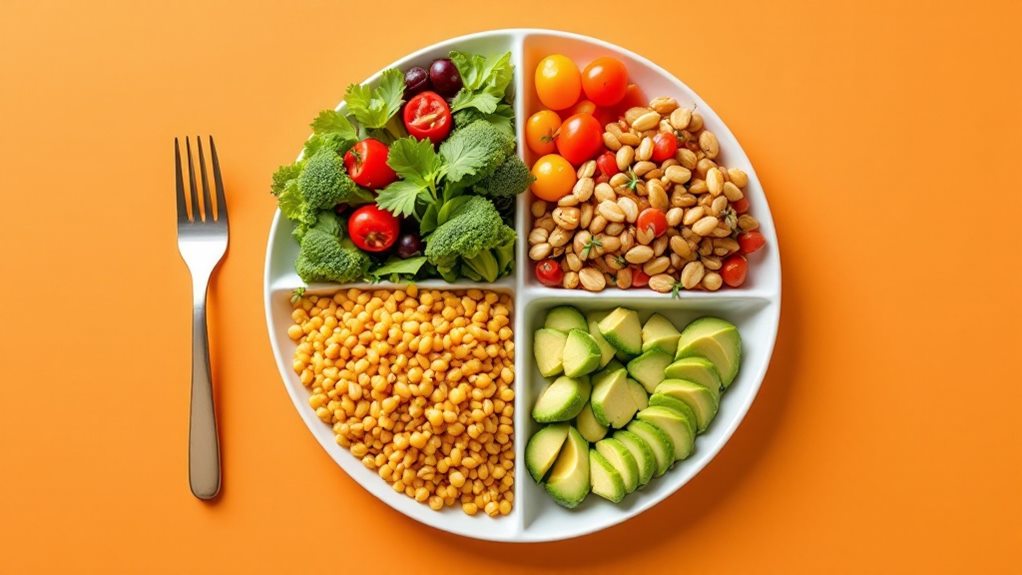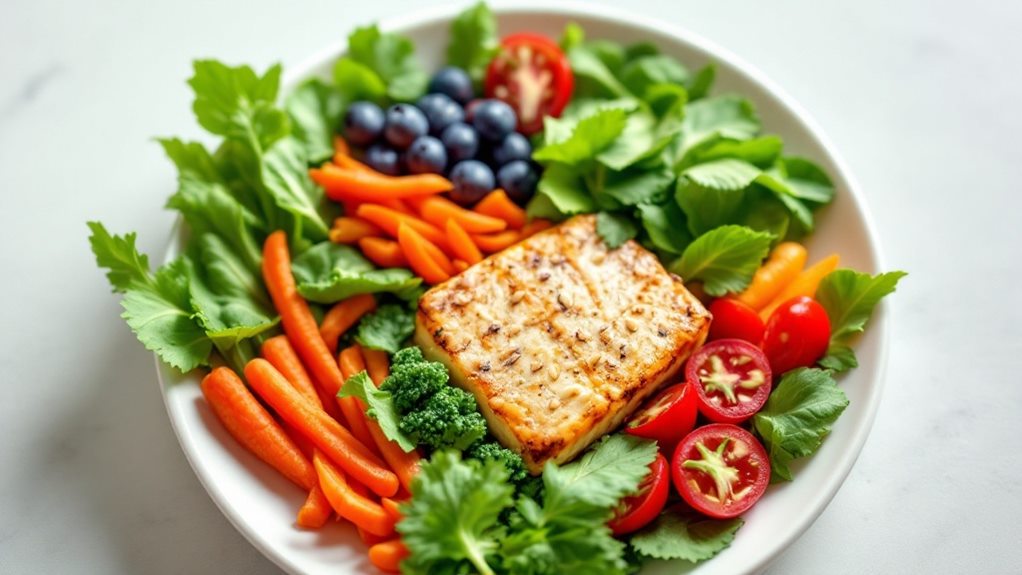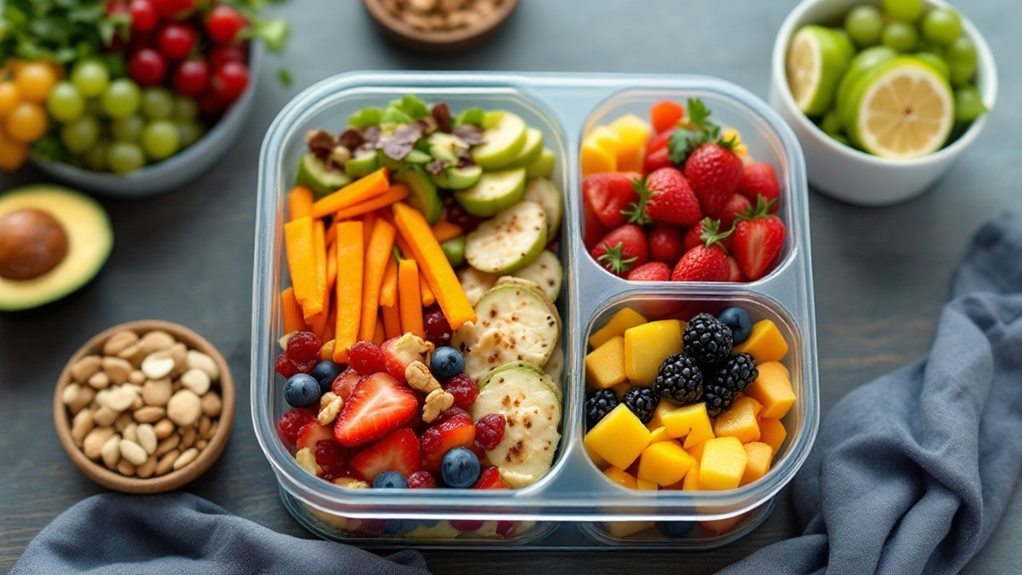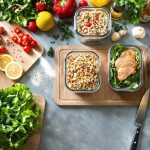You’ll start by dedicating one day a week to organizing meals and making a grocery list. Focus on whole foods divided into appropriate portions and use the “Create Your Plate” method: 25% lean protein, 25% carbohydrates, and 50% non-starchy vegetables. Plan meals around whole grains, lean proteins, and colorful vegetables to enhance satiety and meet nutritional needs. To maintain balance, understand serving and portion sizes, and incorporate batch cooking for efficiency and leftovers. As you integrate these strategies, you’ll find it easier to tailor your meals to your individual needs and continue building a healthier relationship with food.
Key Points
- Start Small: Begin with planning two or three meals per week to build confidence in meal planning[2][4].
- Create Your Plate: Allocate 25% to lean protein, 25% to carbohydrates, and 50% to non-starchy vegetables for balanced meals[4][5].
- Set a Dedicated Day: Designate one day weekly for meal planning, grocery list creation, and cooking[2][3].
- Prioritize Whole Foods: Focus on whole grains, lean proteins, and a variety of fruits and vegetables for optimal nutrition[1][4].
- Portion Control: Understand serving and portion sizes to manage calorie intake and maintain a balanced diet[5].
Planning Meals Ahead of Time
Diving into meal planning starts with dedicating one day a week to organize your meals and create a corresponding grocery list. This step helps save time and money as you’ll be buying exactly what you need, reducing food waste and unnecessary purchases.
Start small by planning two or three meals for the week, gradually building your confidence and ease with meal prep.
To create balanced meals, focus on whole foods divided into appropriate portions. The “Create Your Plate” method is a simple guideline: 25% lean protein, 25% carbohydrates, and 50% non-starchy vegetables. This balance guarantees you’re getting a variety of nutrients without overloading on any single food group.
Incorporating batch cooking can also make meal planning more efficient. Preparing multiple meals at once can leave you with convenient leftovers that can be frozen in individual portions, minimizing waste and making subsequent meals easier to prepare.
Understanding Serving and Portion Sizes
Serving sizes are defined amounts of food or drink consumed, found on nutrition labels to guide calorie and nutrient understanding. Portion sizes, however, refer to the amount of food you choose to eat, which can exceed the recommended serving size and should be adjusted based on individual dietary needs[2][4].
To help you visualize portion sizes, here’s a simple guide:
| Food Group | Recommended Serving Size |
|---|---|
| Vegetables | 1 cup raw, ½ cup cooked |
| Fruits | 1 medium whole, ½ cup cut |
| Grains | 1 slice bread, ½ cup cooked |
Tracking your food intake can help establish baseline calorie requirements and inform appropriate portion sizes for balanced meals. Using hand-portion size methods can also provide personalized guidance on portion control. For example, a fistful of cooked pasta or a palm-sized portion of lean protein can help guarantee your meals align with your individual caloric and nutritional needs[1][3].
Building a Balanced Plate

You’re about to create a balanced plate that guarantees you’re getting the nutrients you need.
Start by filling half your plate with a variety of non-starchy vegetables and fruits, aiming for a range of colors to maximize nutrient diversity.
Then, allocate 25% to lean proteins like chicken, fish, legumes, or tofu, and the remaining 25% to whole grains or carbohydrates like brown rice or quinoa.
Balancing Food Groups
Balancing food groups is essential for creating a balanced plate, especially since each food category offers unique nutritional benefits. To achieve balanced meal composition, you need to take into account the proportions of different food groups on your plate.
Start by filling half your plate with non-starchy vegetables like broccoli, spinach, or carrots. These veggies provide essential nutrients, keep calorie counts low, and promote fullness and satisfaction.
Next, allocate 25% of your plate to lean proteins such as chicken, fish, or legumes. These foods help build and repair tissues and maintain muscle mass.
Reserve the remaining 25% for whole grains or healthy carbohydrates like quinoa or brown rice. These foods offer fiber and energy to fuel your daily activities.
Don’t forget to incorporate a variety of colors and textures on your plate by selecting different fruits and vegetables. This approach enhances nutrient diversity and encourages consumption of a broad range of vitamins and minerals.
Portion Control Tips
Practical Portion Control Guide
| Food Group | Portion Size Guide |
|---|---|
| Non-starchy vegetables | Fill half of your plate |
| Lean protein | About the size of your palm |
| Carbohydrates | About the size of your fist |
| Fats | About the size of your thumb |
| Activity-based portions | Adjust based on activity level |
To further enhance portion control, aim for a variety of colors and textures on your plate. This not only makes meals visually appealing but also encourages nutrient diversity and can aid in identifying different food groups. Practice mindful eating by slowing down and paying attention to hunger and fullness cues to prevent overeating and guarantee a balanced approach to each meal. This mindful approach helps you tailor your meal plan to your dietary needs and guarantees healthy meals.
Healthy Meal Composition
Craft a balanced meal by focusing on the composition of your plate. Using the Create Your Plate method, you can build meals that are both satisfying and nutrient-dense. This approach emphasizes filling half your plate with non-starchy vegetables, a quarter with lean protein, and a quarter with carbohydrates like whole grains or fruits. This balance not only optimizes nutrient intake but also enhances satiety.
To create a healthy meal, consider these key elements:
- 1. Variety: Incorporate a mix of food groups in each meal. This could include fruits, vegetables, whole grains, and healthy fats, which not only meet dietary needs but also enhance flavor.
- 2. Portion Control: Adjust portion sizes based on individual caloric needs. Using hand-portion size methods can guide personalized meal planning.
- 3. Fiber Intake: Aim for 25-30 grams of fiber daily by including plenty of whole foods like fruits, vegetables, and whole grains to support digestion and overall health.
- 4. Visual Appeal: Emphasize color and texture in meals. Visually appealing and diverse plates can enhance enjoyment and promote mindful eating habits.
Incorporating Whole Foods
To incorporate whole foods into your diet, focus on including a variety of unprocessed foods like fruits, vegetables, whole grains, lean proteins, and healthy fats in your meals.
Start by replacing processed items with whole food alternatives, such as choosing whole grains like quinoa and brown rice over refined grains, and opting for lean protein sources like chicken, turkey, and fish.
Choosing Whole Foods
Incorporating whole foods into your diet is an essential step towards guaranteeing a diverse and nutrient-rich intake. By choosing a variety of fresh fruits, vegetables, whole grains, lean proteins, and healthy fats, you’ll maximize your nutrient intake and minimize unnecessary additives.
Choosing Whole Foods: Key Strategies
1. Select Plain or Minimally Processed Options:
Opt for plain or minimally processed frozen fruits and vegetables to avoid added sugars and preservatives. This guarantees you get the most nutritional value from these foods.
2. Prioritize Whole Grains:
Choose whole grains like brown rice, quinoa, and whole-wheat bread instead of refined grains. Whole grains are rich in fiber, which helps promote satiety and supports digestive health.
3. Include Healthy Fats:
Add healthy fats such as avocados, nuts, or olive oil to your meals. These fats improve nutrient absorption and provide essential fatty acids.
4. Go Seasonal:
Prioritize seasonal produce for freshness and flavor. This not only enhances meal enjoyment but also supports local agriculture, promoting a healthier and more sustainable food system.
Preparing Balanced Meals
Preparing balanced meals regularly is vital for maintaining a healthy diet. When you focus on incorporating whole foods into your meals, you’re guaranteeing a rich nutrient profile that supports overall well-being. Start by prioritizing lean proteins like chicken and legumes, whole grains such as quinoa and brown rice, and a wide range of colorful fruits and vegetables.
To create a balanced meal, aim for a composition that includes 25% lean protein, 25% carbohydrates, and 50% non-starchy vegetables. This not only enhances fullness but also provides essential nutrients. Use the Create Your Plate method to visually balance your meals by filling half your plate with fruits and vegetables, and the other half with grains and protein sources. This promotes a diverse intake of macronutrients.
To save time and increase freshness, batch cook meals using seasonal produce and plan for leftovers. This minimizes waste and guarantees quick access to balanced meals throughout the week.
Don’t forget to incorporate healthy fats like avocados, nuts, and olive oil into your meals to enhance flavor and satiety. These fats play a vital role in nutrient absorption and overall health, making your meals nutritious and satisfying.
Prioritizing Mindful Eating

Prioritizing mindful eating is essential for developing a healthier relationship with food and enhancing your overall well-being. By paying full attention to the experience of eating and drinking, you can lead to greater satisfaction and reduced calorie intake. This approach helps you recognize hunger and fullness cues, making healthier food choices a natural part of your routine.
When you engage all five senses during meals—savoring flavors, appreciating textures, and enjoying aromas—you enhance the eating experience and promote a more conscious approach to food.
Here’s how you can start prioritizing mindful eating:
- Notice Your Hunger and Fullness Cues: Use tools like the hunger-fullness scale to identify your personal hunger levels, encouraging you to eat when hungry and stop when satisfied.
- Engage All Five Senses: Savor flavors, appreciate textures, and enjoy aromas to enhance the eating experience.
- Eliminate Distractions: Set aside phones and televisions during meals to focus on your food, leading to improved digestion and greater enjoyment.
- Foster a Positive Relationship with Food: Practice mindful eating to reduce emotional eating and promote healthier food choices, appreciating each meal and fostering a positive relationship with food.
Creating a Shopping List
As you shift from planning meals to grocery shopping, creating a well-organized shopping list becomes essential. Start by categorizing your list into sections like fruits, vegetables, proteins, grains, and dairy. This helps you guarantee a balanced selection of foods and streamlines the grocery shopping experience.
Use your meal plan to determine the ingredients needed for each meal, which minimizes impulse purchases and food waste by only buying what you’ll use. Take advantage of seasonal produce to enhance freshness and nutrient content while keeping costs down. In-season fruits and vegetables are often cheaper and more flavorful.
Additionally, monitor your pantry staples and refill items like whole grains, canned beans, and spices to guarantee you have a well-rounded selection of ingredients for balanced meals at home.
Consider using digital apps or templates to create and manage your shopping list, allowing for easy updates and organization as you plan meals for the week. This structured approach to grocery shopping guarantees that your meal plan translates into healthy, balanced meals without unnecessary expenses.
Managing Leftovers and Snacks

Smart meal planning includes making the most of what you have. Preparing meals that yield leftovers not only saves time but also reduces your reliance on takeout options. By freezing leftovers in individual portions, you can help prevent food waste and guarantee you have healthy meals ready to go when time is tight.
For example, soups can last 2-3 months in the freezer.
When it comes to snacks, portioning them into single servings helps control caloric intake while making it easier to grab healthy options. Here are some tips for managing leftovers and snacks effectively:
- Freeze Leftovers: Individual portions of leftovers can be frozen for up to 3-4 months, guaranteeing a steady supply of healthy meals.
- Portion Snacks: Divide snacks into single servings to control caloric intake and encourage healthier choices.
- Choose Satisfying Snacks: Opt for snacks like string cheese or hummus with veggies to provide energy and stave off hunger between meals.
- Keep Snacks Accessible: Store snacks in a designated spot in the fridge or pantry to encourage healthier snacking choices and minimize temptation to reach for less nutritious options.
Involving Family in Meal Planning
Involving your family in meal planning is an essential step towards creating a balanced diet that everyone enjoys.
By engaging family members in the process, you encourage accountability and guarantee meals cater to diverse tastes and dietary needs.
Start by setting up family input sessions where everyone shares their preferences and helps decide on meals, fostering a collaborative cooking environment that benefits everyone.
Engaging Family Members
Engaging family members in meal planning is a pivotal step in fostering a culture of healthy eating habits and shared responsibility. By involving everyone in the planning process, you’re making everyone more invested in the meals and encouraging accountability. This not only helps in developing positive attitudes towards balanced meals but also strengthens family bonds through collaboration.
When you engage your family in meal planning, you’re opening up a conversation about favorite foods and meals. This helps tailor the meal prep process to individual preferences, ensuring everyone looks forward to mealtime.
Here are some ways to engage family members effectively:
- Assign Roles: Allocate specific tasks like shopping or cooking to family members to enhance teamwork and create a sense of ownership over meal choices.
- Involve Children: Engage children in the cooking process to help them try new foods and develop a positive attitude towards vegetables.
- Make It Fun: Turn meal planning into a fun family activity to promote collaboration and enjoyment.
- Discuss Preferences: Talk about favorite foods and meals as a family to tailor meal prep to individual tastes, making mealtime more enjoyable for everyone.
In the heart of every home, shared meal planning becomes the cornerstone for fostering a culture of healthy eating habits and mutual responsibility. By involving family members in meal planning discussions, you can tailor meals to everyone’s preferences, increasing participation and engagement in cooking.
Start by discussing favorite foods and creating a shared meal calendar that includes input from all family members. This approach allows for a variety of dishes and minimizes the likelihood of repeated meals.
To make meal planning a collaborative effort, assign specific cooking tasks to each family member based on their skills. This promotes accountability and shared responsibility in meal preparation.
Additionally, involving children in the cooking process can encourage them to try new foods, as studies show that children are more likely to eat what they help prepare.
Make meal planning a fun family activity by setting aside time each week for brainstorming and preparing meals together. This can strengthen family bonds and create lasting traditions centered around eating well and shared responsibility.
Family Input Sessions
To create a balanced and enjoyable family meal plan, start by hosting family input sessions. These sessions allow everyone to share their favorite foods, dietary preferences, and new meal ideas, fostering a sense of ownership and accountability in the process.
By involving your family in meal planning, you encourage healthy eating habits and make mealtime more enjoyable.
Key Points to Implement in Family Input Sessions:
- Schedule Weekly Sessions: Set aside a specific day each week for family members to contribute ideas and vote on meal options.
- Use Shared Tools: Utilize a shared calendar or meal planning app to organize family contributions and track meals, ensuring everyone is informed and engaged.
- Incorporate Children’s Suggestions: Include kids’ favorite dishes and new food ideas in the meal plan to encourage variety and adventurous eating.
- Make It Fun: Turn meal planning into a fun activity by involving the family in cooking sessions, reinforcing positive eating habits while spending quality time together.
This approach not only promotes healthy eating but also strengthens family bonds.
Strategies for Meal Prep Success

Effective meal prep begins with a clear, actionable plan. You start by preparing just two to three meals each week, focusing on lunches to reduce your reliance on takeout and save time during busy weekdays.
Dedicate a specific day for meal prep, setting a time limit, such as two hours, for shopping and cooking. This approach helps streamline the process and makes it more manageable.
To maximize efficiency, incorporate batch cooking strategies by preparing larger quantities of meals that can be portioned out for multiple days. This reduces cooking time later in the week and can provide healthier, whole food options.
Utilize freezer-friendly recipes and label prepped items with dates to guarantee freshness and minimize food waste.
Involving family members in meal planning and preparation can promote accountability and make cooking a fun, shared activity.
This collective approach helps maintain a balanced diet and fosters good health habits. By implementing these strategies, you can create a meal prep routine that not only saves time but also supports your overall health and well-being.
Tailoring Meals to Individual Needs
When it comes to meal planning, a one-size-fits-all approach often falls short, especially considering the diverse nutritional needs of individuals. To truly benefit from meal planning, it’s crucial to tailor meals to your specific needs.
Start by evaluating your dietary needs based on factors such as age, gender, activity level, and any health conditions. This will help determine your ideal macronutrient ratios, which typically fall within the range of 45-65% carbohydrates, 20-35% fats, and 10-35% protein.
To make meal planning more effective, consider the following steps:
- Determine Your Macronutrient Needs: Use your evaluated dietary needs to establish specific macronutrient ratios.
- Use the Create Your Plate Method: Allocate 25% lean protein, 25% carbohydrates, and 50% non-starchy vegetables on your plate, adjusting based on personal preferences and nutritional goals.
- Incorporate Variety: Include a range of food groups such as whole grains, fruits, and healthy fats to guarantee a balanced intake of essential nutrients.
- Track and Consult: Use apps or journals to track your food intake and consult regularly with a registered dietitian or nutritionist to receive personalized advice and adjustments to your meal plans.
In Summary
Weaving a Balanced Plate: The Fabric of Healthy Eating
Imagine your plate as a canvas, where each meal is a masterpiece of colors, textures, and flavors. By planning meals ahead, you’re the artist, creating a balanced picture that nourishes both body and soul. Incorporinate whole foods, manage portions, and involve your family in the art of cooking. Each meal is a thread in the tapestry of a healthy diet, intertwining to form a vibrant, balanced life. Prioritize mindful eating, and let your plate be your masterpiece.














